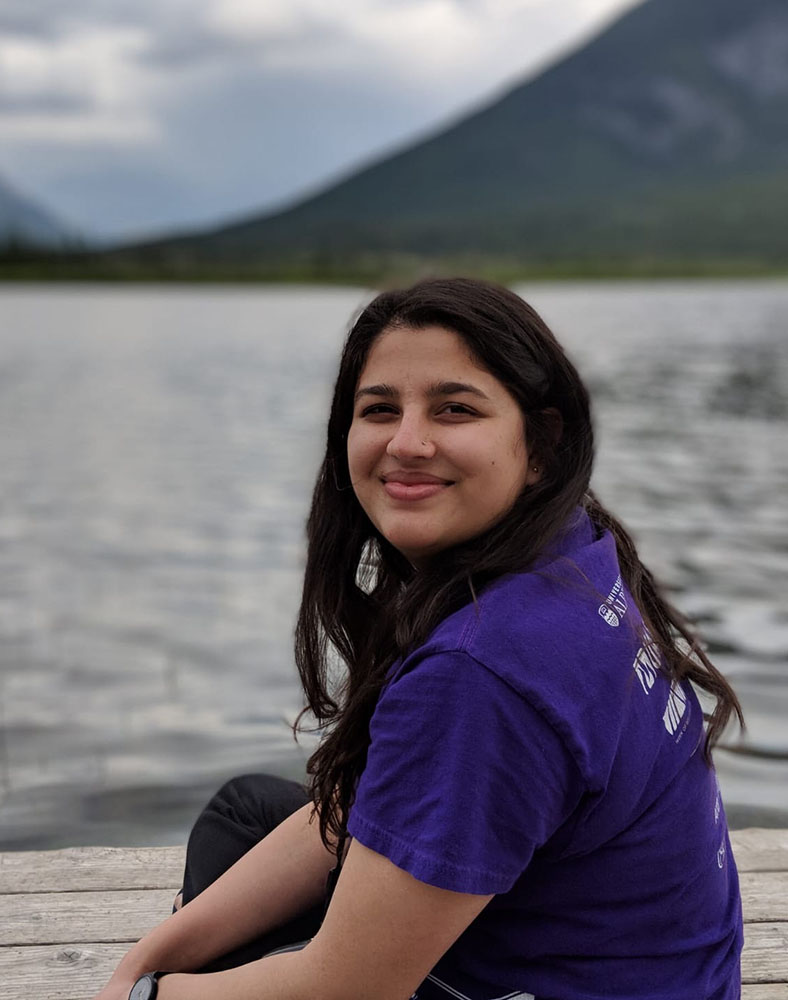Convocation ‘20: Anna Chakravorty
Erik Einsiedel - 5 June 2020

Art & Design graduate student Anna Chakravorty’s research uses augmented reality (AR) to help arachnophobes overcome their fear of spiders.
Pursuing her Masters of Design in Visual Communication Design, Anna is blending her passions for animation, storytelling and design with her desire to provide solutions for mental healthcare. The result is a concept for an AR game that allows arachnophobia patients to use a virtual reality headset which, under the supervision of a psychologist, enables them to begin interacting with “cartoonish” animated spiders. The spiders are designed to grow progressively more realistic as the user advances through the game levels, as a form of exposure therapy but using only digitally crafted spiders.
Her project has made headlines in Folio, CTV and Global News, and is poised to enter the prototype stage once she partners with a software developer. Anna sees the potential for AR games to support mental health, with similar applications designed to improve the patient experience.
As the nature of her project incorporates elements of design, technology and psychology, she credits her time with the Faculty of Arts as having helped her grow as a researcher, learning the value of multidisciplinary research and collaborating with others.
What drew you to the area of your study?
My research topic was to design an augmented reality (AR) platform for arachnophobia treatment. I wanted to understand how one can design interactive AR game narratives to help patients to overcome their fears.
There are three areas of passion that made me choose my research topic. The first one was animation and storytelling. Since childhood, I have loved reading graphic novels, playing video games, and creating stop-motion animations and stories. I come from the generation of 2D screens, so when I experienced my first 360 degree virtual reality-based movie called The Bond, directed by Olly Reid, I was left dumbfounded. I believe your first experience is very important in VR. I was transported to a new reality where I could actually interact with characters. It felt for the first time I could breathe life into my imaginary world.
The second passion was a challenge to myself. I have immense fear of honeybees and have strong disgust emotions towards insects. Fear develops into hate, and that can affect one’s thinking and actions. Hence, through my research, I wanted to build resilience and have more control on my mind.
My third passion is design. Design in its definition is a method of identifying problems and gaps in a certain system, and finding solutions that address both functional as well as emotional needs, thereby increasing the efficiency of the system.
My research adds to the novel knowledge and frameworks of using user experience design with augmented reality games, with applications for mental healthcare solutions. My goal is to help patients overcome their fears by building empathy with their feared stimuli, and help therapists improve their efficiency in their therapeutic practices.
What is the most remarkable thing you learned while you were a student?
I have learned a lot during my study at the U of A. I have not only grown academically, but I have grown as a researcher and as a person. Learning the perspective of different fields through my multidisciplinary research helped me to build better relationships with others and communicate effectively with a wider audience.
Did you face any significant challenges, and if so, how did you deal with it?
The biggest challenge was limited available research, as I was working on a novel solution. Explaining design as a concept to people outside the design world was a challenge, but it also motivated me to develop my research in a way that can be comprehended by everyone.
How did you manage the challenges of navigating student life under COVID-19 restrictions and remote learning?
I completed my thesis before COVID-19, but was still instructing the Design Fundamentals course to undergraduate students. The biggest challenge was to conduct critique sessions as it required rigorous discussion and interaction with offline handmade work which is difficult to share remotely. Accordingly, we improvised through the Miro software which facilitated the process through options like interactive whiteboarding, sticky notes, note drawing and card sorting which the students felt comfortable with. Maybe in the future we can have AR classes from our homes!
What piece of advice do you wish someone had given you when you started?
Don’t be afraid to ask for help and engage in discussions. Don’t just stick to your demographic, you will learn a lot when you step out of your bubble. Find and participate in university competitions such as the Three Minute Thesis (3MT), Falling Walls, and Images of Research. It helps you communicate your research with a wider audience, test your research, and make better decisions.
What is next for you?
I would be happy as long as I am applying my learnings to an industrial setting, sharing my knowledge, and making a change in my own way by giving back to the community. I am also open to the option of doing a PhD if the right opportunity presents. Currently, I am expanding my research into different areas of mental health.
The Future is Arts! This story is part of a series celebrating our graduates. Please join us for a virtual convocation, Friday, June 12, at 10 a.m. MST. at ualberta.ca. Registration is not required.